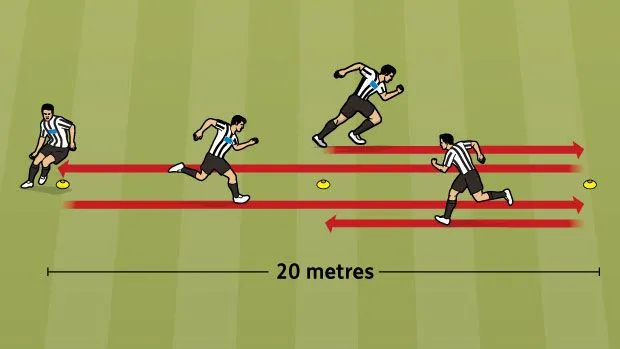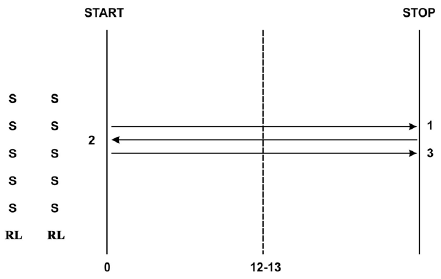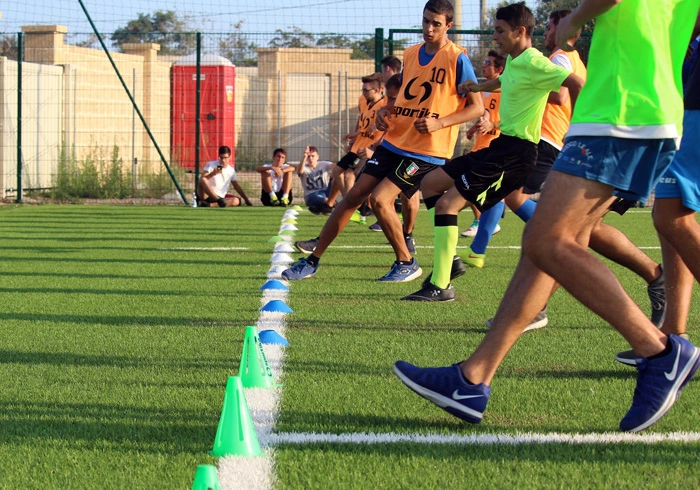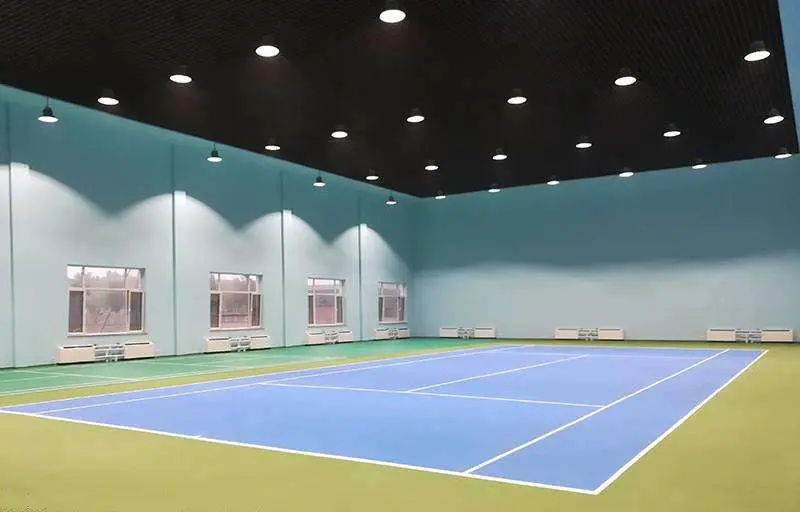
The shuttle sprint, often referred to as the shuttle run, is a popular form of fitness training and testing involving running back and forth between two set points quickly and explosively.
The distance between the two points can vary based on the individual’s fitness level and specific training goals.
The shuttle run is a seemingly simple movement that’s now shown up in the CrossFit online quarter-finals; it will likely be in many online competitions for the foreseeable future.
A shuttle sprint is a high-intensity interval training (HIIT) exercise involving running at full speed between two points. It enhances your speed, agility, and cardiovascular endurance.
The shuttle run & sprint can be a part of any fitness regimen, and it’s often used in various military fitness tests and training programs, including the Army Physical Fitness Test (APFT) and Army Combat Fitness Test (ACFT).
Army PRT Shuttle Sprint Run Exercise
The shuttle sprint is the third exercise in Military Movement Drill 1 (MMD1).
There are two more exercises in the mm2 drills:
Purpose:
- The shuttle sprint run exercise prepares the soldier for more vigorous anaerobic endurance, leg speed, and agility activities.
Here is a breakdown of the exercise as an individual soldier would conduct it
Starting Position:
- The starting position is the staggered stance with the right foot forward.
- The right heel is even with the toes of the left foot.
- The head is up, looking straight ahead
- The knees are slightly bent
- The left arm is forward
Movement:
- From the starting position, run quickly to the 25-meter turnaround point. (as arrow 1 in the following exercise illustration shows)
- Turn clockwise while planting the left foot and bending and squatting to touch the ground with the left hand.
- Run quickly back to the starting line (arrow 2)and plant the right foot.
- Then turn counter-clockwise and touch the ground with the right hand.
- Run back to the 25-meter turnaround (arrow 3), accelerating to maximum speed through the finish.

Check Points:
- Soldiers should slow their movement before planting feet and changing direction
- Soldiers should squat while bending the trunk when reaching to touch the ground as they change direction
- Soldiers touch the ground with their left hand on the first turn, then with their right hand on the second turn
- Accelerate to near maximum speed during the last 25-yard interval
Precaution:
- Soldiers should use caution when performing the shuttle run exercise on wet terrain.
Figure 10-6. Shuttle sprint
Shuttle Runs Techniques
For the shuttle run, I will cover specifically about 25 feet worth of a shuttle running segment, its implications, the different styles we have, and a few things to look out for during the shuttle runs.
Key Characteristics of a Shuttle Run
- It’s only a 25-foot section. So you will never reach top speed, as expected in a 100-meter sprint.
- The name of the game when it comes to shuttle running is all about acceleration.
Focus Points in Shuttle Running
- Prioritize your running gait or rhythm.
- Try to always accelerate out of every single turn you make.
- We don’t want to have to chop and change your steps every time you get to that 25-foot line or any line you’re turning on; try to change your foot pattern or running gait to stay closer to the line you’re touching.
Types of Shutte Run Turns
Side on Turn
- Side-on-turn is probably more useful for lower reps, moving faster, or sprint-style workouts.
- You’ll stay side-on, turn about 90 degrees, touch the floor, and turn out again, hitting the next 90 degrees.
Early Rotating Turn
- Start an early turn as you approach your 25-foot mark or whatever the line is.
- That will allow you to then bump out like a three-point stance.
| Type of Turn | When to use | How to perform |
|---|---|---|
| Side-on Turn | Lower reps, faster, or sprint style workouts | Stay side on, turn about 90 degrees, touch the floor, and then turn out again. |
| Early Rotating Turn | Longer runs | Start an early turn as you approach your mark, allowing you to bump out like a three-point stance. |
Foot Position and Touching the Floor
- Think about having a lead leg and a trailing leg, just like you’d expect to see someone in a three-point stance.
- Consider how you touch the floor. Whichever foot is in front, touch it with the opposite hand.
Advice for Practice and Training
- Try and change your stance each time.
- Try to start each set with a different side in training.
Constant Acceleration and Momentum
- It’s a battle of constant acceleration, that three-point stance; wherever you are, the shoulders want to be forward.
- We don’t want to be touching and leaning back. It should be a touch as we touch the floor, and we can drive out of that three-point stance.
- So once you’ve touched it, you can then move straight into my next rep.
Remarks
I hope those tips help with your shuttle runs. As always, practice in isolation first before you go into a competitive-style workout with shuttle runs.
Benefits of Shuttle Runs & Sprints
Shuttle running and sprinting has a variety of benefits, as follows:
Cardiovascular Health
- Shuttle sprinting, a high-intensity exercise, helps improve cardiovascular health by strengthening your heart and lungs, reducing blood pressure, and improving blood circulation.
Weight Loss
- This exercise quickly burns many calories due to its high intensity. It also boosts your metabolism, helping you burn more calories at rest.
Improving Speed and Stamina
- Shuttle runs, or sprints, are an effective way to improve your speed and stamina.
- The explosive nature of the exercise challenges your muscles and cardiovascular system, leading to improved performance over time.
Agility Training
- Due to the swift change in direction, the shuttle sprint is an excellent agility training exercise, improving your ability to change direction quickly and efficiently.
Shuttle Sprint Workouts and Drills

Basic Workout Routine
- A basic shuttle run sprint workout could involve sprinting between two points with a rest interval in between.
- You can vary the distance, number of repetitions, and rest interval based on your fitness level and goals.
Shuttle Drills for Athletes
- For athletes, drills may involve combining shuttle sprints with sport-specific movements or skills, such as dribbling a ball or performing agility ladders.
Shuttle Drills for Soccer Players
- Soccer players can integrate shuttle sprints with ball control drills to improve their agility and ball-handling skills while fatigued.
- This combination fosters improved performance by effectively challenging their abilities.
Shuttle Runs for Basketball Players
- Basketball players can benefit from shuttle runs combined with dribbling or shooting drills to mimic game situations.
Football Speed
- Football players can use shuttle runs to improve their speed off the line and during gameplay.
- They can combine sprints with tackling or passing drills for a comprehensive workout.
Interval Training
- Shuttle sprint interval training involves alternating periods of high-intensity exercise with rest or low-intensity exercise periods.
- Incorporating shuttle runs into interval workouts can boost cardiorespiratory fitness and facilitate fat burning.
- This structured approach optimizes results and enhances overall workout efficacy.
How to Increase Stamina with Shuttle Runs
- Increasing the distance, reducing rest intervals, or increasing the number of repetitions are ways to make shuttle runs workouts more challenging and build stamina.
Training for Marathon Runners
- Marathon runners can use shuttle running to enhance speed and cardiovascular endurance.
- They also provide a break from monotonous long runs.
Shuttle runs for kids.
- For kids, shuttle runs can be incorporated into games or challenges to make them fun and engaging while still providing fitness benefits.
Military
- The military has incorporated shuttle runs in their physical fitness test, and a good example is the Air Force Shuttle Run event, which is part of the Air Force Fitness Test.
Special Applications of Shuttle Sprints

Indoor Shuttle running Exercises
- You can perform indoor shuttle runs in a gym or any spacious indoor area.
- Ensure the surface is non-slip and the space is free of obstacles for safety.
Shuttle Sprinting in Small Spaces
- In smaller spaces, shuttle sprinting can still be effective.
- Just shorten the distance between the two points.
- You can increase the number of repetitions to compensate for the shorter length.
Shuttle runs with resistance bands.
- Adding resistance bands to your shuttle runs can increase the difficulty and muscle engagement of the exercise, leading to greater strength and speed gains.
Conclusion
The shuttle sprint is a powerful exercise that improves speed, agility, and cardiovascular health.
Proper technique and progressive training can help you reach your fitness goals related to sports performance, weight loss, or overall fitness.
Incorporating shuttle sprints into your regular workout routine can provide variety and a high-intensity element that boosts your metabolism and enhances your athletic performance.
Frequently Asked Questions (FAQs)
Shuttle running works the muscles in your lower body—the glutes, quads, hamstrings, and calves. They also engage your core and arm muscles.
Shuttle running depends on your fitness level and goals. 1-3 times a week is sufficient to reap the benefits of shuttle sprints.
Improving your sprint time requires speed training, strength training, and technique refinement. Progressive movement and consistency are fundamental.
Yes, shuttle runs are an excellent choice for HIIT workouts due to their high-intensity nature.
Due to its high-intensity nature, shuttle sprinting is an effective calorie-burning exercise.
- Empowering Transactions: Navigating Firearms Sales with Proper Documentation - April 8, 2024
- Army PRT – Preparation and Recovery 2024 - March 18, 2024
- Active and Reserve Components 2024 - March 6, 2024
